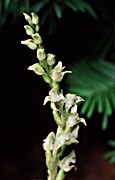Goodyera oblongifolia Raf.
Menzies' rattlesnake plantain, giant rattlesnake plantain
The specific epithet oblongifolia is the Latin meaning "oblong
leaf," referring to the relatively oblong leaves of this species.

Photo courtesy of Mark Larocque
DESCRIPTION: Plant pubescent
above the leaves, 15-40 cm tall (including inflorescence), arising from
a rhizome supported by a cluster of slightly fleshy, fibrous roots. Leaves
3-7, forming a basal rosette, petiolate, oblong-elliptical to elliptical,
5-10 cm long and 2-4 cm wide, dark green or blue-green with a prominent
white stripe along the midrib. Inflorescence a downy, loose spicate
raceme 15-40 cm tall, 10-30 flowered, typically secund, each flower subtended
by a small, lanceolate bract. Sepals ovate-lanceolate to ovate, 5-10
mm long and 3-4 mm wide, white and smooth inside, the outer surfaces pubescent
and greenish, lateral sepals typically smaller than dorsal sepal and reflexed
at the tips; dorsal sepal connivent with petals to form a hood over the
column. Petals obovate or spatulate, 5-10 mm long and 3-4 mm wide,
closely appressed to the dorsal sepal, white. Labellum concave to
loosely saccate, the apex prolonged into an blunt point (looking somewhat
like a spout), 4-8 mm long and 3.5-5 mm wide, white.
SIMILAR SPECIES: Most likely to be confused with other species of Goodyera.
Its large size and unique leaves, however, easily distinguish it from the
other species of Goodyera found in Wisconsin.
HABITAT: Typically found in Hemlock or Hemlock/hardwood forest along
the shores of Lakes Superior and Michigan. Plants are rarely found more
than a few miles inland from the two lakes.
FLOWERING DATES: August 1-20.
POLLINATION: Unknown, but most likely by bumblebees, similar to the
other species of Goodyera.
DISCUSSION: Goodyera oblongifolia is a primarily western United
States species, and shows a classic periglacial disjunct distribution. This
relict distribution may have been important in its hybridization with G.
repens var. ophioides, which produced the hybrid species G.
tesselata. For a detailed discussion of this, see the two papers by
Kallunki listed in the references.
WI DISTRIBUTION:  U.S. DISTRIBUTION:
U.S. DISTRIBUTION:
Go directly to Wisconsin herbarium
records.
Return to the main LIST of
the Orchids of Wisconsin.
Return to the main KEY to the Orchids of
Wisconsin.

 U.S. DISTRIBUTION:
U.S. DISTRIBUTION: